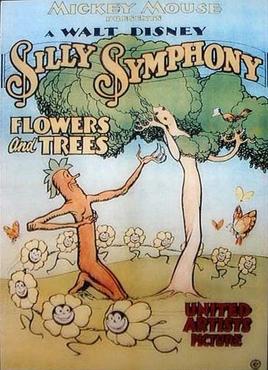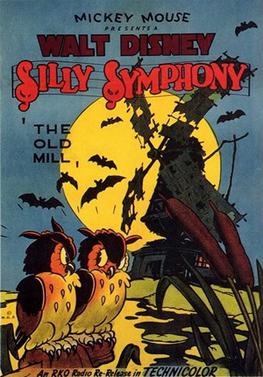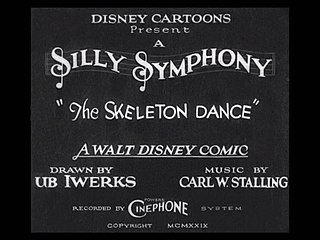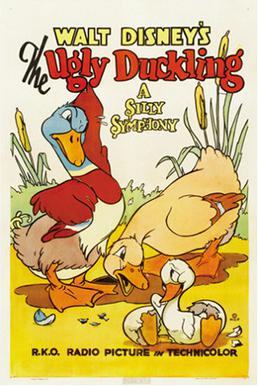Related Research Articles

The Wise Little Hen is a 1934 Walt Disney's Silly Symphony cartoon, based on the fable The Little Red Hen. The cartoon features the debut of Donald Duck, dancing to "The Sailor's Hornpipe". Donald and his friend Peter Pig try to avoid work by faking stomach aches until Mrs. Hen teaches them the value of labor.

Flowers and Trees is a Silly Symphonies cartoon produced by Walt Disney, directed by Burt Gillett, and released to theatres by United Artists on July 30, 1932. It was the first commercially released film to be produced in the full-color three-strip Technicolor process after several years of two-color Technicolor films. The film was a commercial and critical success, winning the first Academy Award for Best Cartoon Short Subject.

The Old Mill is a Silly Symphonies cartoon produced by Walt Disney Productions, directed by Wilfred Jackson, scored by Leigh Harline, and released theatrically to theatres by RKO Radio Pictures on November 5, 1937. The film depicts the natural community of animals populating an old abandoned windmill in the country, and how they deal with a severe summer thunderstorm that nearly destroys their habitat. It incorporates the song "One Day When We Were Young" from Johann Strauss II's operetta The Gypsy Baron.

The Skeleton Dance is a 1929 Silly Symphony animated short subject with a comedy horror theme. It was produced and directed by Walt Disney and animated by Ub Iwerks. In the film, four human skeletons dance and make music around a spooky graveyard—a modern film example of medieval European "danse macabre" imagery. It is the first entry in the Silly Symphony series. In 1993, to coincide with the opening of Mickey's Toontown in Disneyland, a shortened cover of the cartoon's music was arranged to be featured in the land's background ambiance. The short's copyright was renewed in 1957, and as a published work from 1929 it will enter the US public domain on January 1, 2025.
Music Land is a Silly Symphony animated Disney short released in 1935.

The Ugly Duckling is an animated short film by Walt Disney, based on the 1843 fairy tale "The Ugly Duckling" by Hans Christian Andersen. The film was directed by Jack Cutting and Clyde Geronimi, and released in theaters on April 7, 1939. Music was composed by Albert Hay Malotte, who was uncredited for the film. The animated short was first distributed by RKO Radio Pictures, and was shown with Love Affair.
Egyptian Melodies is a 1931 Silly Symphonies animated short subject produced by Walt Disney and directed by Wilfred Jackson.
The Ugly Duckling is an animated black-and-white cartoon released by Walt Disney in 1931 as part of the Silly Symphonies series. This cartoon was later remade into a color version released in 1939, which follows the original Andersen story much more faithfully. This gives The Ugly Duckling the unique distinction of being the only Silly Symphony to be made twice. This film was then sold to reach about 4,000 dollars per month at the most profit, because it slowly climbed up the scale of growth.
Mother Pluto is a Silly Symphonies cartoon released on November 14, 1936, directed by Wilfred Jackson. The cartoon features Pluto.
The Flying Mouse is a Silly Symphonies cartoon produced by Walt Disney, directed by David Hand, and released to theatres by United Artists on July 14, 1934. The use of color here was rather innovative as it is set during the course of a single day.

The Robber Kitten is a 1935 Walt Disney Silly Symphonies cartoon, directed by David Hand.
Who Killed Cock Robin is a Silly Symphonies short released on June 26, 1935, by United Artists, produced by Walt Disney and directed by David Hand. It is based on the nursery rhyme Who Killed Cock Robin?. It was nominated for the Best Short Subject (Cartoons) Oscar but lost to Disney's own Three Orphan Kittens.
Mother Goose Melodies is a 1931 Silly Symphonies animated film, directed by Burt Gillett. Two years later it was semi remade in Technicolor as Old King Cole.
The China Plate is a 1931 Silly Symphonies animated film.
The Busy Beavers is a 1931 Silly Symphonies animated film, directed by Burt Gillett.
The Cat's Out is a Silly Symphonies animated Disney short film. It was released in 1931. The Cat's Out was a working title that survives on an existing vault print; the short was originally copyrighted and released as The Cat's Nightmare.
Funny Little Bunnies is a Silly Symphonies animated Disney short film. It was released in 1934.
Peculiar Penguins is a Silly Symphonies animated Disney short film. It was released in 1934. The song played during the cartoon is called "The Penguin Is a Very Funny Creature", by Leigh Harline.

Farmyard Symphony is a 1938 Silly Symphonies animated short film. It can be seen as a precursor to Fantasia due to using various pieces of classical music in one short. The film was directed by Jack Cutting and produced by Walt Disney.

Water Babies is a Silly Symphonies cartoon released on May 11, 1935, by United Artists. The cartoon was directed by Wilfred Jackson. It features 2-inch-tall nude babies playing games in and out of the water. The babies are all completely identical other than the color of their hair. The edited version of the cartoon eliminates some shots that feature nude baby bottoms as a sight gag.
References
- 1 2 3 Merritt, Russell; Kaufman, J. B. (2016). Walt Disney's Silly Symphonies: A Companion to the Classic Cartoon Series (2nd ed.). Glendale, CA: Disney Editions. pp. 86–87. ISBN 978-1-4847-5132-9.
- ↑ Duvall, Earl; Taliaferro, Al; Osborne, Ted; De Maris, Merrill (2016). Silly Symphonies: The Complete Disney Classics, vol 1. San Diego: IDW Publishing. ISBN 978-1631405587.
- ↑ "Talking Shorts". Variety : 20. April 15, 1931. Retrieved February 23, 2020.
- ↑ "Silly Symphonies: The Historic Musical Animated Classics DVD Review". DVD Dizzy. Retrieved February 20, 2021.